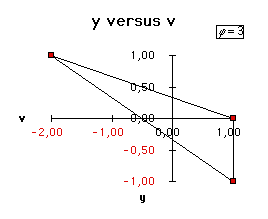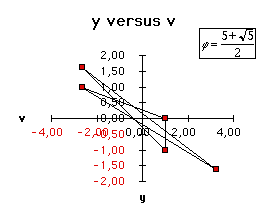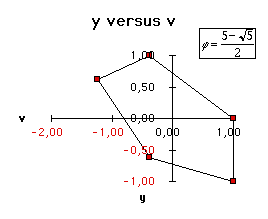Algebraic view
The basic simplified dynamic system is defined by
|
|
Equ. 1
|
where ![]() .
.
Let ![]() be
the current point in
be
the current point in ![]() , and
, and ![]() the matrix of the system. So we have
the matrix of the system. So we have ![]() and, more generally,
and, more generally, ![]()
So the system is completely defined by M.
The eigenvalues of M are:
 |
Equ. 2
|
We see immediately that the value j=4 is special. We will see below what it means.
For j # 4 we can define
a matrix A so that ![]()
(if j =4, A-1 doesnít exist).
For example, from the canonical form ![]() we find
we find

In order to have simpler formulas, we can multiply by 2j, to produce a matrix A:
![]()
So if we define ![]() we can now write
we can now write
![]()
that is to say we have, finally, ![]()
But L is a diagonal matrix, so we have simply ![]()
In particular, we have a cyclic behavior if and only if ![]() (or, more generally if
(or, more generally if ![]() ).
This just means that we have the system of two equations:
).
This just means that we have the system of two equations:
![]()
Case j<4
For j<4, the eigenvalues are complex, and there is always at least one (real) solution for j.
More precisely we can write
![]()
with ![]() and
and ![]()
and then
![]()
and cycles are given by any q
so that ![]()
So for each t, the solutions for j are given by
![]()
Table 1 gives some nontrivial values of j
for which the system is cyclic.
|
|
|
|
|
|
|
|
|
|
|
|
|
|
|
|
|
|
For any other value, the system is just quasi-cyclic (see Figure 4).
We can be a little bit more precise. Below, ![]() is the 2-norm (the Euclidean one for a vector).
is the 2-norm (the Euclidean one for a vector).
We have here

For example, for v0=0 and y0=1, we have
![]()




Case j>4
If j>4, then e1
and e2 are real numbers (and ![]() ),
so we have either
),
so we have either
So, and this is the point, there is no cyclic behavior
for j>4. And, in fact, the distance from
the point ![]() to the center
(0,0) is strictly increasing with t.
to the center
(0,0) is strictly increasing with t.
We have
![]()
So

But we can also write

So, finally, ![]() is
increasing "like"
is
increasing "like"![]() .
.
This result can be used to prevent the "explosion" of the system by defining "constriction" coefficients.
Case j=4
We have here ![]()
In this particular case, the eigenvalues are both equal
to -1, and there is just one family of eigenvectors, generated by ![]() .
So we have
.
So we have ![]() .
.
So, if P0 is an eigenvector, proportional
to V (that is to say if ![]() ),
we just have two "symmetrical" points, for
),
we just have two "symmetrical" points, for
![]()
In the case where P0 is not an eigenvector,
we compute directly how ![]() is decreasing and/or increasing. Let us define
is decreasing and/or increasing. Let us define ![]() .
.
It is easy to see (by recurrence) we have has the following form:
![]()
where at,bt,ct
are integer numbers so that ![]() for
for ![]() .
.
Now, letís suppose for a particular t we have ![]() .
What about
.
What about ![]() ?
?
We easily compute ![]() .
.
This quantity is positive if and only if vt
is not between (or equal to) the roots ![]()
Now, if we compute ![]() we have
we have![]() , and the roots are
, and the roots are![]() .
As
.
As ![]() , it means that
, it means that ![]() is also positive.
is also positive.
So as soon as ![]() begins to increase, it does so infinitely.
begins to increase, it does so infinitely.
But it can be decreasing, at the beginning. How many times ?
Suppose we have D0 < 0.
It means v0 is between -2y0 and -12y0. For instance in the case y0>0, we can write
![]() , with
, with ![]()
By recurrence, we have then

![]() , with
, with ![]()
Finally, we can write
![]()
as long as
![]()
that is to say (for t is an integer) as long as
![]()
After that, ![]() increases.
increases.
We can do exactly the same analysis for y0<0. In this case e<0 too, so the formula is the same.
In fact, we can even be more precise. If we define
![]()
then we have
![]()
That is to say ![]() is decreasing/increasing almost linearly when t is big enough. In
particular, even if it begins to decreases, after that it tends to increase
almost like
is decreasing/increasing almost linearly when t is big enough. In
particular, even if it begins to decreases, after that it tends to increase
almost like ![]() .
.